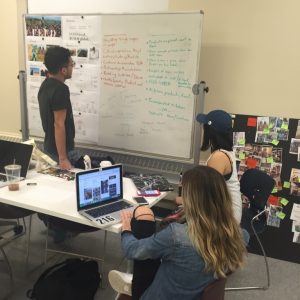In today’s fast-paced marketplace, retailers are always striving to be at the forefront, designing their stores of the future, endeavoring to make their mark and beat the competition to the punch. Yet we see more and more retailers closing stores based on their ability to sell product. But what if we all took a breath, stepped back and slowed down. What would this mean? Would this allow retailers and designers to place priority on creating communities which share similar values, congregating people around the brand’s purpose rather than just their product? (And could this notion of community transform the future of retail store experiences?)
Based on what we know about millennial and Generation Z shoppers, the role of brick-and-mortar stores is changing. Research show that these generations intend to change the world, making its inhabitants more environmentally and socially conscious. Overwhelmingly, they believe that people and corporations should be active citizens working toward the betterment of their local and global communities through environmentally and socially sustainable business practices. Becoming active citizens themselves, millennials and Gen Z are speaking with their purchases and becoming more loyal to brands that share their values, hence the rise of “products with a purpose,” products with the intent of creating a social and environmental impact, and “generous brands,” companies that go beyond simply giving and take action for social and environmental change.
But are retail store experiences keeping up with what these younger generations desire? Are the designed retail experiences for stores of the future creating a platform for a sustainable future?
As I mentioned in my last blog, few retailers, even those that are inherently environmentally and socially conscious, are capturing these ideals within their retail environments and product merchandising.
As the popularity of the maker movement has shown, there is also value placed on products where the authentic and responsible story behind its manufacturing process is told. There is a willingness to spend a little more and buy less when there is a deeper connection to the product. This “slower consumption” movement also illustrates this younger demographic’s desire to reduce their environmental footprint by reducing consumption and extending product lifecycles. But are retail stores being designed with this in mind? Are brands helping consumers repair or recycle their products?
To design a retail experience that aligns with these generations’ values why not ask these very consumers to redefine retail design and design their own stores of the future? That’s exactly what my retail design studio, the Department of Design at The Ohio State University (Columbus, Ohio) is doing this semester! As VMSD Editor-in-Chief Jennifer Acevedo announced last month, with the magazine’s support, my studio is tackling some of these theoretical issues that could redefine the future of retail.
Advertisement
Photo Courtesy of Rebekah L. Matheny, Columbus, Ohio
In the spirit of participatory and multidisciplinary design, we have formed design teams of seniors from all three of our disciplines: interior design, industrial design and graphic communication. Over the course of the studio project, these teams are asked to define what they desire from a retail experience, to reflect on their personal values of environmental and social sustainability, and to select a brand that they believe aligns with their ethics and which currently does not have a physical store experience. They are challenged to reinvent what it is to be a retailer in today’s marketplace, reconceptualizing the retail journey and service model to go beyond simply selling products to cultivating community and promoting product longevity.
In order to create a more sustainable future, these millennials will design a retail space that, from their perspectives, creates a meaningful and memorable connection between the brands’ purpose, the product, the physical environment and themselves. They are also charged with redefining the service model of a retail experience to promote responsible consumption and prolong product lifecycles. Leveraging their design research, the teams will develop a strategy of retail storytelling elements to not only communicate the brands’ ideologies, but to also educate consumers and influence behaviors toward environmental and social good.
Photo Courtesy of Rebekah L. Matheny, Columbus, Ohio
Together, VMSD and I hope to utilize this studio collaboration to challenge the conventions of retail design, to push the boundaries without being beholden to the practicalities of a client or programmatic constraints. This studio can begin to redefine the purpose of a retail space, placing the experience and creation of community above product sales and rethink the services offered when community and product longevity is paramount to social and environmental sustainability.
What is the future of retail? These future retail designers hope to answer that question through this studio!
Advertisement
Rebekah L. Matheny is the assistant professor of interior design in the Department of Design at The Ohio State University (Columbus, Ohio), where she teaches courses in interior finish materials, lighting design and design studios that integrate a retail brand strategy process. Matheny’s research investigates the sensory perception of interior finish materials and their application in retail design to create an emotional connection between the customer and the brand. Follow Rebekah and her journey with materials on Instagram @rebekahmathenydesign and to start a dialogue about the sensory experience of materials visit her web site interiormaterialsmatter.com


 Photo Gallery3 days ago
Photo Gallery3 days ago
 Headlines1 week ago
Headlines1 week ago
 Sector Spotlight2 weeks ago
Sector Spotlight2 weeks ago
 Headlines1 week ago
Headlines1 week ago
 Headlines4 days ago
Headlines4 days ago
 Headlines2 weeks ago
Headlines2 weeks ago
 Designer Dozen1 week ago
Designer Dozen1 week ago
 Headlines2 days ago
Headlines2 days ago

















